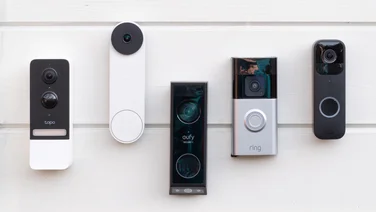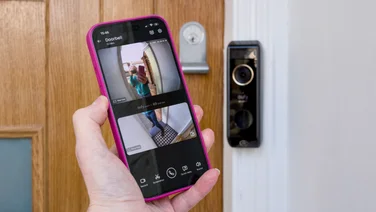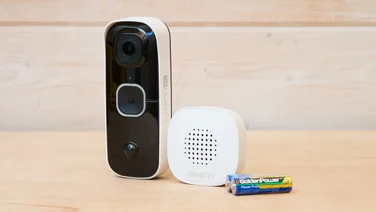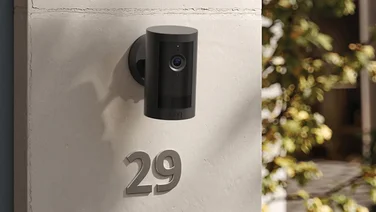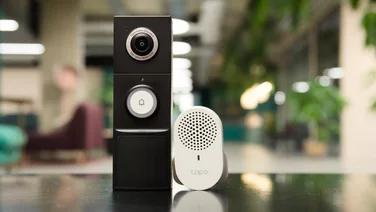To help us provide you with free impartial advice, we may earn a commission if you buy through links on our site. Learn more






- Crisp video and clear audio
- Mains powered
- Face, motion and sound event triggers
- Expensive compared with rivals
- Complicated to install
- Subscriptions are pricey
Video doorbells are the next big smart-home thing, it would appear. First popularised by Ring and latched onto by a security-conscious public over the past year or so, the number of these devices on consumers front doors if a straw poll of my local area in north-east London is anything to go by has skyrocketed. So much so that Googles smart-home arm Nest now has its own video doorbell: the Nest Hello.
READ NEXT: Nest Cam IQ review
Nest Hello review: What you need to know
The idea behind the Nest Hello is pretty similar to the products Ring offers. Its a doorbell with a camera, microphone and speaker embedded in it and a wireless connection that connects it to your home Wi-Fi network.
This allows you to see whos at the door through a smartphone app, record clips of comings and goings automatically, and even talk to people who come to the door when youre not in.
As yet, the Nest Hello is the only product of its type Nest offers, and the first thing to be aware of is that its not yet available as a battery-powered device like the Ring.
Its mains-powered-only and, unless youre a keen DIYer, installation is quite involved, so Id recommend getting a friendly electrician to put it in for you or take advantage of the £100 installation fee Nest itself charges. It also doesnt come with a chime in the box. Youll have to buy one of those separately, too.






Nest Hello review: Price and competition
That makes the Nest Hello potentially much more expensive than its main rival, the Ring Video Doorbell 2. The bell itself is £229 and if you include installation its £329. If youre not replacing a classic wired doorbell, this isnt covered by the Nest installation fee, so youll need to budget extra for the running of new wires and the cost of a chime box as well.
The Ring 2, on the other hand, costs a more reasonable £179. Its powered by a rechargeable lithium-ion battery, and all but the most DIY-phobic should be able to install it in around 15 to 20 minutes. Even if you buy the Ring with the Wi-Fi chime extender which Id recommend the price is £199, and that too is very easy to set up.
Next, youll need to take into account the cost of subscriptions. If you want to take advantage of the Nest Hellos advanced features continuous video history, storage and download, familiar face recognition and timelapse clip creation youll have to stump up at least £40 per year, with different tiers available depending on how long you want to access the video recorded via the Nest Hellos camera.
Buy the Nest Hello from nest.com
Nest Hello setup, features and design
Despite the higher price, there are definitive advantages to Nests approach. Because it doesnt have a battery built in, its much more elegant than the Ring 2 and it looks much less like a security camera, too. Because its a mains-only device, theres no battery to pull out and recharge every couple of months or so, and its nice to have full integration with your existing door chime if you have one.
The Nest Hellos video resolution isnt as high as the Ring Video Doorbell 2. Its 1,600 x 1,200 (recorded on a 1/3in sensor), where the Ring 2 records 1,920 x 1,080 video. In most other respects, however, the Nest matches or betters its rival.
The first area of superiority is that the Nest records video 24/7, just like a regular security camera, and it saves that video direct to Nests servers. This means you can review any minute of the day, where the Ring 2 records clips only when it detects motion.
The level of subscription you buy determines how far back you can go in your video history. The cheapest £30-per-year subscription gets you access to continuous video recording five days into the past; the next level up is £40 per year for ten days; and if you want a full month (30 days), its an incredibly pricey £200 per year.






Rings subscriptions, conversely, are far more reasonable. You dont get continuous video recording, but at £25 per year for 60 days of access to your recorded clips, its much more flexible.
It is possible to run a Nest Hello without one of these subscriptions. Youll still get alerts on your phone when someone rings the doorbell, and youll still be able to carry out a conversation remotely via the doorbells speaker and microphone when youre not in.
But if you do, youll miss out on many of the systems more advanced features. You wont be able to access your continuous video recordings, for a start, and youll also be blocked from the Nest Hellos cleverest features.






The most interesting of these is the Hellos familiar face alerts feature, which works in a similar fashion to Nests IQ security cameras. Whenever someone new comes to the door, the app asks you if you want to ignore or add that person to your list of familiar faces. Then, whenever that person comes to the door again, the idea is that you get a personalised announcement of who’s at the door.
Oddly, and frustratingly, this doesnt work quite in the way you’d expect it to. Its key attraction is that it’s supposed to announce the name of the person via your Google Home or Home Mini smart speaker. However, in all the time I’ve been testing the doorbell this hasn’t worked; instead, the speaker announces merely that “someone is at the door”. It’s the same situation with the app: look at the event stream and all you can see or filter by is “familiar faces”. In fact, the only time I saw named notifications was in my phone’s dropdown notifications.
The technology clearly works but there’s something clearly broken about the way this information is sent to the app and to Google’s smart speakers. That’s disappointing but something that could and should be fixed in a software update.
The ability to create timelapse movies of sections of saved video is another neat feature, as is the closeups feature, which automatically zooms in on areas of action when something happens within the frame. These are considerably less useful than knowing when your kids get home from school, however.

The Nest Hello doesnt neglect the basics, either. Video quality is crisp and clear, as is the speaker and audio quality; HDR ensures the camera copes with tricky lighting conditions well; and infrared LEDs mean it can see in the dark.
Its wonderful being able to converse with couriers and let them know where to leave a parcel but, if you dont want to talk yourself, the Nest Hello also offers a list of canned responses you can use.
The one big caveat, perhaps, is that with continuous video recording, youll be using an awful lot of data on a day-to-day basis. In Low quality mode, this equates to 30GB per month, in Medium quality its 120GB per month, and in High quality its a mind-boggling 300GB per month.
It is possible to disable the recording to a schedule or to disable it automatically while youre home, but that does negate its usefulness as a security device somewhat. Essentially, you need an uncapped data plan to make the most of the Nest Hello. If you dont have one, this isnt the product for you.
Nest Hello review: Verdict
The Nest Hello is clearly a fantastic product. It works beautifully, and its more elegant and far more clever than its main rival, the Ring 2 video doorbell. However, it suffers from the same issues as the rest of the Nest cameras in the range.
The first is that its expensive to buy and install, considerably more so than the Ring 2, and the second is that the subscription is more expensive, at £40 per year for the cheapest plan. Its also pretty data-hungry.
All these factors mean that, while brilliant, the Nest Hello isnt for everyone. Its replete with clever and convenient features, and a step ahead of the Ring Video Doorbell 2 in terms of features, but overall Id say the Ring just edges it.



